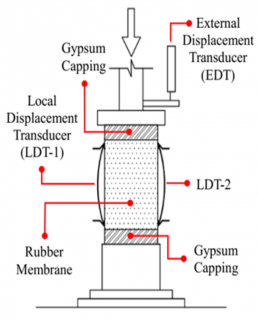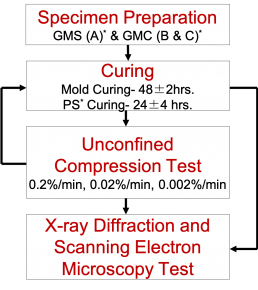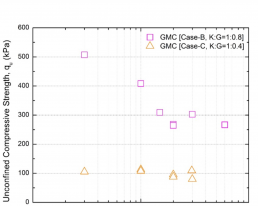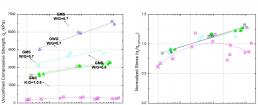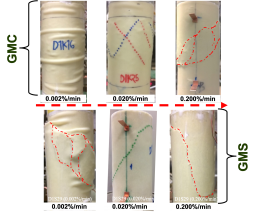Introduction / 序論
Recycling gypsum waste has become a matter of great concern over years due to its tremendous annual production and related environmental consequences when deposited in the landfill. Gypsum has a high potential of being used as a ground improvement material and the present study focuses on understanding different aspects of gypsum treated geomaterial.
Gypsum(石膏、セッコウ)は年間大量に廃棄され埋立地を圧迫するため、石膏の廃棄物のリサイクルは長年の課題となっている。石膏は地盤改良材料としてのポテンシャルがあり、本研究は石膏による固化を行った土の挙動やその原因の理解を目的とする。
Schematic illustration of testing condition / 試験装置の模式図
*GMS-Gypsum Mixed Sand
*GMC- Gypsum Mixed Clay
*PS- Polythene Sheet
Experimental procedures / 試験条件
Curing effect on peak strength properties / 養生時間のピーク強度への影響
Mechanical Response under Different Strain Rates and Curing / 異なるひずみ速度と養生時間による力学的挙動の違い
With the aim to understand the loading rate dependency of gypsum treated geomaterial, prepared specimens were subjected to strain rates ranging from 0.002%/min to 0.200%/min (100 times) under unconfined condition. In addition, failure modes were also recorded to better understand the mechanism. Results reveal that GMS represent greater rate dependency than GMC with apparent to single shear band formation at/near the peak. Unlike GMS, GMC showed an initial increase in peak strength with strain rate increment but eventually starts declining at greater strain rate. Moreover, longer curing time seems to be prominent on the strength properties of GMS than GMC.
石膏固化土の挙動のせん断速度依存性を理解するため、0.002%/min から 0.200%/minまでのひずみ速度で供試体をせん断した。さらにメカニズムの把握のために破壊モードも写真として記録した。その結果、GMS(砂を固化したもの)はGMC(粘土を固化したもの)よりもよりせん断速度に影響を受けることがわかった。GMSとは違い、GMCはひずみ速度が大きくなった時にややピーク強度が上昇したが、より大きなひずみ速度では最終的にピーク強度が下がった。また、養生時間が長くなると、GMSとGMC共にピーク強度が小さくなった。
Strain rate dependency on peak strength properties of GMS & GMC / GMSとGMCのピーク強度のせん断速度依存性
Typical failure pattern of GMC and GMS / GMCとGMSの典型的な破壊パターン
Microstructural Characteristics of Gypsum Treated Geomaterial / 石膏固化土の微視的な特徴
SEM tests and microscopic analysis performed on the GMC and GMS provided insight regarding micro-structural changes occurred due to gypsum treatment. Comparing the microstructure before and after gypsum addition, it can be hypothesized that, during hydration gypsum crystals (dihydrate) precipitated as needle-shaped form which develops an interlocking mechanism binding the kaolin/sand hence modifying the morphology. In general, such integrated microstructure reduces the pore volume and improves the mechanical properties of the mixture (Kitazume & Terashi, 2013).
SEMによる微視的な分析をGMCとGMSに対して行い、石膏固化による微視的構造の変化の理解を目指した。石膏を加える前後で水和の際に石膏の結晶が針状となって、カオリン(粘土の一種)や砂を拘束しよりインターロッキングが起きやすくなると考えられる。一般的に、そうした形態の変化は間隙を小さくし、固化土の力学的特性を向上する。(Kitazume & Terashi, 2013)
